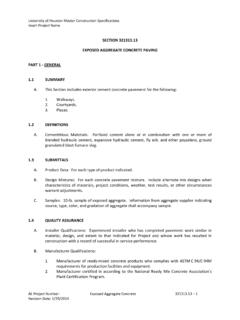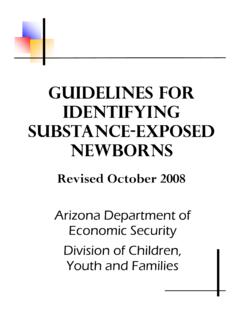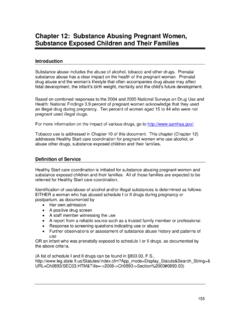Transcription of Exposed Paper and Foil Faced Insulation
1 Paragon Property Services Inc, 2010 Permission for reproduction is granted, provided the entire article is reproduced, including this notice Paragon Property Services Inc., 1426 Greenleaf, Evanston IL - 847-721-0776 - Exposed Paper and Foil Faced Insulation FAQ Prepared By Michael Thomas Paragon Property Services Inc. The most current version of this document can be found on-line at: Fig 1. This warning is printed on all Paper and foil Faced Insulation manufactured in for sale in the United States, but is often ignored by installers. Q. What s the Cliff Notes version of this FAQ? A. If you can see Paper or foil Faced Insulation at a property, the facing needs to be removed or covered with inch drywall or replaced with a different type of Insulation with a low flame-spread facing.
2 In some situations is facing is wrong not only because it is a fire hazard but because it is in the wrong location it should be opposite the side of the Insulation you can see. All these situations are discussed in more detail below. Paragon Property Services Inc, 2010 Permission for reproduction is granted, provided the entire article is reproduced, including this notice Paragon Property Services Inc., 1426 Greenleaf, Evanston IL - 847-721-0776 - Q. Why have you reported that Exposed Paper Faced Insulation is a fire hazard despite the fact that fiberglass batt Insulation is commonly installed this way? A. Leaving the Paper and/or foil facing of Insulation Exposed is prohibited by International Residential Code (IRC), which is the most common building code adopted and used in the United States for one and two family dwellings and All US manufacturers of Paper and foil Faced Insulation prohibit such installation in their printed instructions and on the Insulation s packaging materials2, and the North American Insulation Manufactures Association (NAIMA) requires its manufacturer members to print the warning shown in the picture above on all conventional Paper and foil Faced fiberglass Insulation products sold in the Q.
3 My contractor / builder / architect says that there are exceptions to this rule for concealed spaces such as attics and crawl spaces, and that the Paper Faced Insulation at my property is allowed. A. While this is a widely held belief, it s an urban construction Q. Is Exposed combustible facing really a serious hazard? A. While " Insulation fires" account for around .5% (one-half of one percent) of residential fires, flame-spread across combustible facings can contribute to more rapid fire spread. This is a serious enough problem that current US building standards prohibit Exposed Paper facing, and that some countries (such as Canada) prohibit the sale or installation of Paper Faced fiberglass Insulation Q. What are my options to correct the problem?
4 A. There are several options, depending on the requirements of your application. 1) If a vapor retarder is not required in your application, the Exposed Paper or foil facing can be removed, leaving unfaced fiberglass as the Exposed surface. (If the facing was supporting the Insulation , it will have to be re-secured in some other manner). 2a) If a vapor retarder is required in your application and 1) the facing is on the correct side of the wall to serve as a vapor retarder and 2) the Paper or foil barrier is a sufficient vapor retarder, then the Exposed Paper or foil facing can be covered with gypsum board ( drywall ) providing this is acceptable to your local building department or other authority having jurisdiction. In the case of locations where the drywall may be subject to mechinical damage (such as garages, basements, heavily traveled hallways, etc.
5 You may wish to consider abuse-resistant ( impact resistant ) Paragon Property Services Inc, 2010 Permission for reproduction is granted, provided the entire article is reproduced, including this notice Paragon Property Services Inc., 1426 Greenleaf, Evanston IL - 847-721-0776 - 2b) In our Chicago heating climate Exposed facing is sometimes also incorrectly installed as reversed vapor retarder . This is a separate problem, but can effect how Exposed Paper facing is corrected. This problem occurs when 1) an optional or required Paper or foil vapor retarder is Exposed 2) and the Insulation is also incorrectly installed with facing serving as a vapor retarder on the cool in winter side of a floor or wall with heated space on one side and unheated space on the other.
6 In this case if a vapor regarded is required the Insulation can sometimes be removed (if it can be removed intact) and reversed against the warm side of the floor or wall. As a result 1) the facing will now be in substantial contact with the gypsum board on the heated side of the wall (eliminating the fire hazard), 2) the Exposed side of the Insulation will be unfaced fiberglass (which is not a fire hazard) and 3) the required vapor retarder will now be on the correct (warm in winter) side of the floor or 8 3) In cases where a vapor retarder is required and there are many small isolated sections of Insulation or it is difficult to bring gypsum board panels to the Insulation location (for example when the Insulation behind a kneewall is around the corner from the access) it may be cost effective to install special Flame Spread 25 (FS25)
7 Insulation with a facing that meets the flame-spread and smoke-developed index requirements for Exposed Again, check with your building department or other authority having jurisdiction to determine if this is acceptable. 1 The relevant section of the IRC is : Insulation . Insulation materials, including facings, such as vapor retarders or vapor permeable membranes installed within floor-ceiling assemblies, roof-ceiling assemblies, wall assemblies, crawl spaces and attics shall have a flame-spread index not to exceed 25 with an accompanying smoke-developed index not to exceed 450 when tested in accordance with ASTM E 84. Since the standard Paper and/or foil facing of Insulation does not meet these standards, the Insulation is not allowed to be installed with the facing left Exposed .
8 Additionally, the Insulation is required to be installed in accordance with the installation instructions from the manufacturer, these instruction state (refer to the labeling on the Insulation in the photo) "Warning: This facing will burn. Do not leave Exposed . Cover with approved building material in contact with the facing." or similar wording, depending on the manufacturer of the Insulation . 2 For example of a manufacturer s prohibition against Exposed facings see page 1 of the Owings Corning Thermal Batt FIBERGALSS - Product Data Sheet 3 Insulation Facts Publication #30, Insulation and Fire Safety, North American Insulation Manufacturers Association, Paragon Property Services Inc, 2010 Permission for reproduction is granted, provided the entire article is reproduced, including this notice Paragon Property Services Inc.
9 , 1426 Greenleaf, Evanston IL - 847-721-0776 - 4 The opinion that there are such exceptions probably results from misreading the one exception to that applies to Paper Faced fiberglass Insulation : - - Exceptions: - - 1. When such materials are installed in concealed spaces, the flame-spread and smoke-developed limitations do not apply to the facings, provided that the facing is installed in substantial contact with the unexposed surface of the ceiling, floor or wall finish (underline mine). To a casual reader this may seem to suggest that Exposed Paper facings are allowed in some concealed spaces , but it actually says exactly the opposite: that in such spaces the facings do not have to meet ASTM flame-spread and smoke-developed limitations, provided the facing is installed in substantial contact with the unexposed surface of the ceiling, floor or wall finish - that is, with the facing is installed on the inside of the wall or ceiling (the unexposed surface), with the un- Faced , Exposed fiberglass backside of the Insulation Exposed to view.
10 5 Straight Talk About Building Insulation and Fire, Applegate Insulation , 6 For example DensArmor Plus Abuse-Resistant Interior Panels and Sheetrock Brand Abuse-Resistant Gypsum Panels 7 An common example of a reversed vapor barrier in a heating climate like Chicago s is at floor between a heated space on first floor of a house and an unheated crawlspace below the floor. In this configuration the bottom of the floor is colder in winter, so the facing of the Insulation should be up against the bottom of the floor, and if the Insulation is Exposed at the ceiling of the crawl space it should be the unfaced back side of the Insulation . Fig 2. If you can see the Insulation facing on the underside of the ceiling when you are standing in a crawlspace such as this one, you are actually seeing two installation mistakes: 1) the Exposed facing and 2) a vapor retarder on the cold side of a floor.









